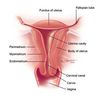The Reproductive System Flashcards
1
Q
What are the primary and accessory sex organs?
A
Primary:
- Males: Testes - Sperm (produce it all the time)
- Female: Ovaries - Eggs (have the same amount they are born with)
Accessory:
- Glands
- External genitalia
2
Q
Name these features

A
- A: Ductus deferens
- B: Penis
- C: Spongy urethra
- D: Seminal vesticle
- E: Prostate gland
- F: Epididymis
- G: Testis
- H: Scrotum

3
Q
What is the passage of sperm?
A
- The gonads are the sperm producing testes which lie in the scrotum
- The sperm then travels to the epididymis duct which is a series of coiled tubes which delays the passage of the sperm to mature them
- Then it passes from outside the body to inside the body throughthe vas deferens or ductus deferenes
- It then passes through the ejaculatory duct
- And finally through the urethra
4
Q
What are the accessory glands for the male reproductive system and what do they do?
A
- Seminal vesicles:
- Adds 60% volume to the semen
- Secrete thick liquid to transport sperm. Includes: fructose (nourish), prostaglandins (reverse peristalsis decrese viscosity in cervix), enzymes
- Helps for transport by adding energy and to reduce hostility and viscosity of the female
- Prostate
- Secrete thin alkaline solution to liquefy semen, neutralise urine and female tract
- Substances to increase mobility
- Bulbourethral glands
- Produces mucous to lubricate urethra
- Neutralises urine and forms a gelatinous plug
5
Q
Fill in the blank table

A

6
Q

A
A: Vas(ductus) deferens
- Long muscular duct
- From epididymis
- Joins duct of seminal vesicle to form ejaculatory duct
- Ejaculatory duct opens in prostate urethra
B: Epididymis
- Single coiled duct, uncoiled = 6m long
- Posterolateral in scrotum
C: Efferent ductules
D: Seminuferous tubule

7
Q

A
- A: Bladder
- B: Ureter
- C: Ductus deferens
- D: Seminal vesicle
- E: Ejaculatory duct
- F: Prostate
- G: Bulbourethral gland

8
Q

A
- A: Opening of the uterine tube
- B: Uterine tube
- C: Fundus
- D: Body
- E: Cervix
- F: Vagina

9
Q

A
- A: Uterine tube
- B: Ovary
- C: Ligament of ovary
- D: Uterus
- E: Bladder
- F: Vagina
- G: Greater vestibular gland
- H: Bulb of vestibule
- I: Glans clitoris

10
Q

A
- A: Infundibulum
- B: Uterine tubes
- C: Ampulla
- D: Isthmus
- E: Fundus
- F: Uterine body and cavity
- G: Cervical canal

11
Q

A
- A: Uterine tube
- B: Ovary
- C: Uterus
- D: Vagina
- E: Bladder
- F: Urethra
- G: Rectum
- H: Anal canal
- I: Anal aperture

12
Q

A
- A: Ovary
- B: Fimbriae
- C: Ligament of ovary
- D: Ampulla
- E: Round ligament of uterus
- F: Isthmus of uterus

13
Q
Fill in the blanks
Ovaries
- Produces _____
- Adjacent to ______ pelvic wall
- ____ long
- Suspended by ___________
A
Ovaries
- Produces ova
- Adjacent to pelvic wall
- 3cm long
- Suspended by mesentry and ligaments
14
Q
Fill in the blanks
Uterine Tubes
- extend laterally from _____
- end in fringe –> _____
- Parts
- _______ - surround by fimbriae
- _______ - usually site of fertilisation
- _______- medial third
A
Uterine Tubes
- extend laterally from uterus
- end in fringe –> fimbriae
- Parts
- Infundibulum - surrounded by fimbriae
- Ampulla - usually site of fertilisation
- Isthmus - medial third
15
Q
What are the parts of the uterus?
A
- Fundus - rounded superior part
- Body
- Cervix - neck
- Uterine cavity
- Wall
- Perimentrium, myometrium, endometrium












